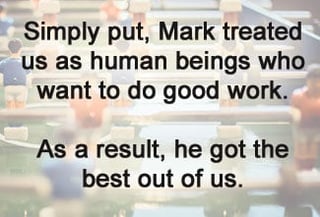Three decades ago – as a first-time manager at the age of 23 – I had a boss named Mark.

Mark was a good guy to work for and a great model for me in my early days as a leader. Mark held high standards for our operations team. He believed firmly in the importance of clear process and procedure. He believed in solid training to quickly get new folks on board and to help us all continuously improve.
What really set Mark apart was his understanding of people. He had an innate sense for how to engage, motivate and bring out the best in us. He knew that leadership isn’t only about driving results. He knew that leaders can’t get results without other people.
Four People-Practices for Good Leadership
Here are four people-practices that Mark consistently applied in his leadership.
- Mark showed gratitude and appreciation for our contributions and good work. On a small scale, this meant that almost every day at the end of our shift, Mark would thank me and others for our work. He’d say, “Thank you for your hard work. I appreciate you being here today.” Some of us would respond, “You’re welcome.” Others of us might say, “No problem” or “That’s why I’m here.”
While it seemed simple, Mark was continuously letting us know that he genuinely valued us as members of his team.
On a larger scale, when we completed projects or made major contributions, Mark made sure he praised the work we did. He shared with us the things he liked about what we delivered. He’d share specifics of what was useful and valuable. He’d also share with us how he felt our work positively impacted the team, our operation or the organization. - Mark involved us in the processes of our department. He asked us, his managers and team members, for our ideas on how to create innovation. He asked for our solutions and perspectives when he was grappling with a business issue or problem. He empowered us to make decisions about many of the business challenges we faced.
Even when the problems we were bringing to him were ones we were personally facing at work, he engaged us in the creative process of solving those problems for ourselves. Sure, he shared his own ideas and thoughts about potential solutions – but first, he always found out what we thought was important, what we perceived and saw, and what we thought would be the best solutions to our problems. - Mark was not only open to our ideas and solutions. Mark was open to being challenged. He was open to our thoughts when they were contrary to his. He was open to our feedback about what was and wasn’t working in our operation. He was even open to thoughts and criticisms we might have about how he was leading our team and department.
Mark explicitly invited these kinds of challenges by asking simple questions: What are your suggestions for how we can make things better? What do you think we need to do differently? What do you think I need to do differently? It was this spirit of openness to feedback, and even to being challenged, that made Mark trustworthy, humble and human to all of us who worked for him. - Mark gave us the freedom to be great. He did this by being very clear about what he expected of us and by making sure we understood and were aligned with what he expected. Then, within that framework of expectations, he allowed us the freedom and autonomy to be creative, bring value and do our best work.
Yet with freedom, as they say, comes responsibility. Mark’s willingness to give us freedom within a clear set of expectations didn’t mean that he just let us run wild. If we strayed too far, he made sure we talked about that, so we could get back on course.
Simply put, Mark treated us as human beings who want to do good work. As a result, he got the best out of us.
I don’t know where Mark learned it, but somehow he knew that people need the right environment and conditions to thrive. In the workplace, those conditions are created by the one who leads the team.
So, as you lead your team, are you leading like Mark? Are you creating the right conditions for your people to give you their best?
If you don’t know the answer – and even if you think the answer is yes – ask your people. They are the best source for learning the real impact you’re having on them as the boss. If you let them, they can teach you how to make that impact better, so they can all perform at their highest levels.
Please welcome Lemberg Guest Blogger, John Rutkiewicz. John has more than 30 years of experience as a leader and manager in fields ranging from sales and marketing to customer service, financial services and human resources. Since 1993, he has provided facilitation, training, coaching and leadership-development support to hundreds of leaders, from front-line supervisors to C-suite executives. John is a facilitator and certified coach for Living As A Leader in Brookfield, WI.